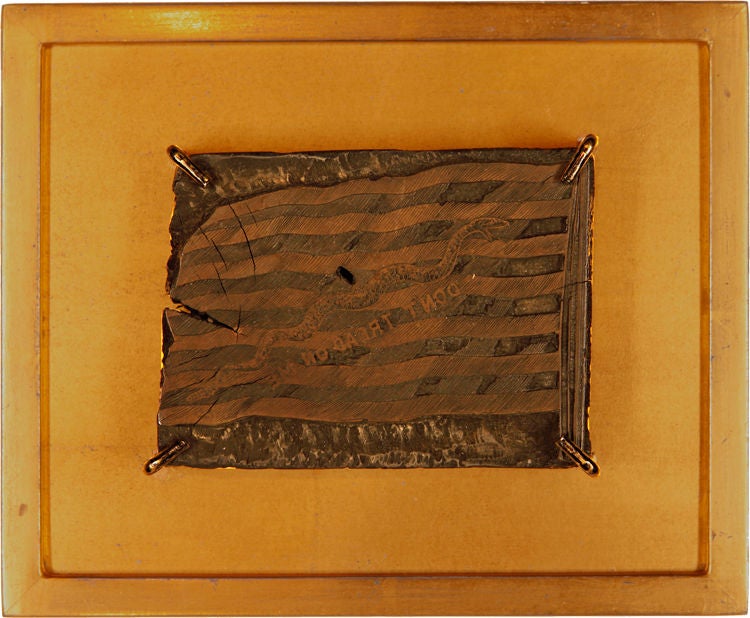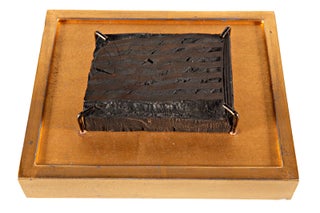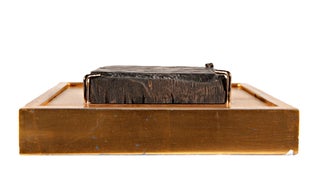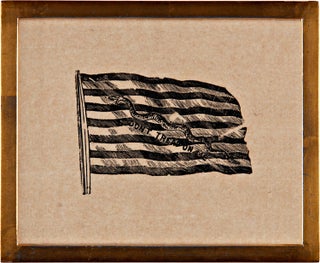American Revolution Original Woodblock: Rattlesnake and “Don’t Tread on Me” Print with Uniformly Framed Modern Impression
American Colonies: ca. 1775. Original engraved boxwood block, 3 x 4 inches, three-quarters-inch deep, together with a uniformly framed modern impression. A few hair-line surface clefts and two larger clefts, one along the flag’s edge and the other at flag center. Exceptionally rare and well-preserved Revolutionary War artifact depicting one of the most famous and enduring symbols and mottos of the colonial fight for independence. Item #47
Remarkable eighteenth-century engraved woodblock depicting an uncoiled rattlesnake against the thirteen-stripe flag emblazoned with the motto “Don’t Tread on Me” set diagonally below. This original woodblock would have been used during the Revolutionary War to reproduce this defiant cartoon in colonial pamphlets, newspapers, and broadsides during the fight for independence. The cartoon’s thirteen stripes represented the thirteen colonies, and the threatening serpent posed a striking warning to those who would dare tread upon their freedom. The rattlesnake was a well-known emblem of American resolve and defiance well before the Revolutionary War. The Pennsylvania Gazette published an article in 1751 (believed to have been authored by Benjamin Franklin) protesting the longstanding British practice of sending its convicts to the colonies, suggesting that, in reply, the colonies ship the British a “cargo of rattlesnakes.” Three years later, during the French and Indian War, Benjamin Franklin published his famous “Join, or Die” political cartoon depicting a rattlesnake cut into eight separate pieces representing the colonial regions. Franklin’s cartoon was meant to portray the impotence of the divided British colonies in the face of French and Native American hostility—and their lethality when united in common cause. During the Revolutionary War, the rattlesnake assumed a new and more potent symbolism for the newly formed navy. Before the departure of the Colonial Navy’s first mission in 1775, Continental Colonel Christopher Gadsden of South Carolina presented Commodore Esek Hopkins with an ensign depicting a coiled rattlesnake to serve as the personal standard of his flagship, and the first enlisted Marines reportedly carried yellow-painted drums depicting a thirteen-rattle serpent and the motto: “Don’t Tread on Me.” The uncoiled rattlesnake depicted in this original woodblock appears to have been described by Benjamin Franklin and John Adams in a 1778 letter to the ambassador of Naples at the Court of France: “Some of the States have vessels of war distinct from those of the United States. For example, the vessels of war of the state of Massachusetts Bay have sometimes a pine tree; and those of the state of South Carolina a rattlesnake in the middle of thirteen stripes.” A design similar to that presented in this woodcut became identified with the “First Navy Jack” of the United States, and variations of the image have been produced by historians throughout the years, though it remains disputed whether this image was, in fact, flown by Commodore Esek Hopkins during the Revolutionary War. The rattlesnake remains one of the most recognized icons of the American Revolution, and the “Don’t Tread on Me” maxim endures as a fierce warning against tyranny and encroachment. Revolutionary War artifacts of this significance remain exceptionally rare in the trade—especially in such a superb state of preservation.
Price: $12,000.00




